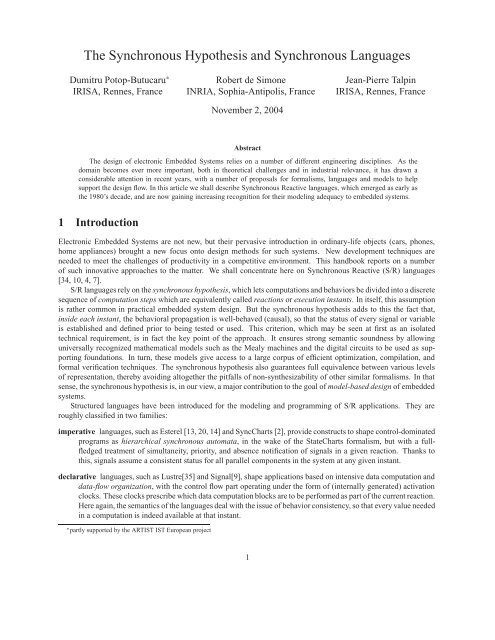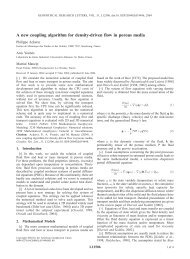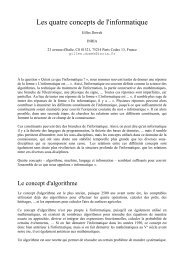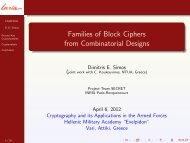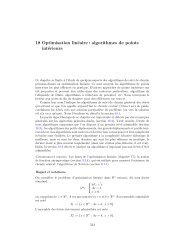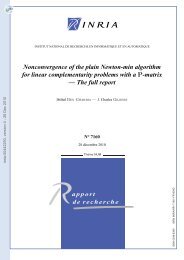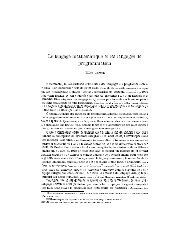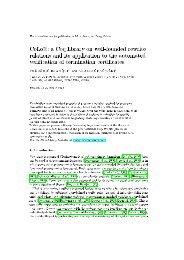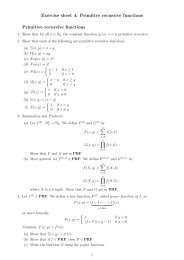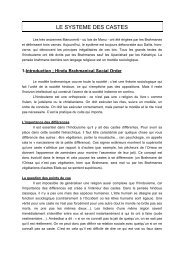The Synchronous Hypothesis and Synchronous Languages - Inria
The Synchronous Hypothesis and Synchronous Languages - Inria
The Synchronous Hypothesis and Synchronous Languages - Inria
Create successful ePaper yourself
Turn your PDF publications into a flip-book with our unique Google optimized e-Paper software.
Signals: broadcast signals are used to propagate information. At each execution instant, a signal can either be presentor absent. If present, it also carries some value of a prescribed type (“pure” signals exists as well, that carry onlytheir presence status). <strong>The</strong> key rule is that a signal must be consistent (same present/absent status, same data) forall read operations during any given instant. In particular, reads from parallel components must be consistent,meaning that signals act as controlled shared variables.Causality: the crucial task of deciding whenever a signal can be declared absent is of utter importance in the theoryof S/R systems, <strong>and</strong> an important part of the theoretical body behind the <strong>Synchronous</strong> <strong>Hypothesis</strong>. This is ofcourse especially true of local signals, that are both generated <strong>and</strong> tested inside the system. <strong>The</strong> fundamentalrule is that the presence status <strong>and</strong> value of a signal should be defined before they are read (<strong>and</strong> tested). Thisrequirement takes various practical forms depending on the actual language or formalism considered, <strong>and</strong> weshall come back to this later. Note that “before” refers here to causal dependency in the computation of theinstant, <strong>and</strong> not to physical or even logical time between successive instants [12]. <strong>The</strong> <strong>Synchronous</strong> <strong>Hypothesis</strong>ensures that all possible schedules of operations amount to the same result (convergence); it also leads to thedefinition of “correct” programs, as opposed to ill-behaved ones where no causal scheduling can be found.Activation conditions <strong>and</strong> clocks: Each signal can be seen as defining (or generating) a new clock, ticking whenit occurs; in hardware design, this is called gated clocks. Clocks <strong>and</strong> sub-clocks, either external or internallygenerated, can be used as control entities to activate (or not) component blocks of the system. We shall also callthem activation conditions.2.3 Mathematical modelsIf one forgets temporarily about data values, <strong>and</strong> one accepts the duality of present/absent signals mapped to true/falsevalues, then there is a natural interpretation of synchronous formalisms as synchronous digital circuits at schematicgate level, or “netlists” (roughly RTL level with only Boolean variables <strong>and</strong> registers). In turn, such circuits have astraightforward behavioral expansion into Mealy FSMs.<strong>The</strong> two slight restrictions above are not essential: the adjunction of types <strong>and</strong> values into digital circuit modelshas been successfully attempted in a number of contexts, <strong>and</strong> S/R systems can also be seen as contributing to thisgoal. Meanwhile, the introduction of clocks <strong>and</strong> presence/absence signal status in S/R languages departs drasticallyfrom the prominent notion of sensitivity list generally used to define the simulation semantics of Hardware Description<strong>Languages</strong> (HDLs).We now comment on the opportunities made available through the interpretation of S/R systems into Mealy machinesor netlists.netlists: we consider here a simple form, as Boolean equation systems defining the values of wires <strong>and</strong> Boolean registersas a Boolean function of other wires <strong>and</strong> previous register values. Some wires represent input <strong>and</strong> outputsignals (with value true indicating signal presence), others are internal variables.This type of representation is of special interest because it can provide exact dependency relations betweenvariables, <strong>and</strong> thus the good representation level to study causality issues with accurate analysis. Notions of“constructive” causality have been the subject of much attention here. <strong>The</strong>y attempt to refine the usual crudecriterion for synthesizability, which forbids cyclic dependencies between non-register variables (so that a variableseems to depend upon itself in the same instant), but does not take into account the Boolean interpretation,nor the potentially reachable configurations. Consider the equation Ü Ý Þ, while it has been establishedthat Ý is the constant true. <strong>The</strong>n Ü does not really depend on Þ, since its (constant) value is forced by Ý’s.Constructive causality seeks for the best possible faithful notion of true combinatorial dependency taking theBoolean interpretation of functions into account. For details, see [52].Another equally important aspect of the mathematical model is that a number of combinatorial <strong>and</strong> sequentialoptimization techniques have been developed over the years, in the context of hardware synthesis approaches.<strong>The</strong> main ones are now embedded in the SIS <strong>and</strong> MVSIS optimization suites, from UC Berkeley [50, 30]. <strong>The</strong>ycome as a great help in allowing programs written in high-level S/R formalisms to compile into efficient code,either software or hardware-targeted [51].Mealy machines: Mealy machines are finite-state automata corresponding strictly to the synchronous assumption. Ina given state, provided a certain input valuation (a subset of present signals), the machine reacts by immediately3
producing a set of output signals before entering a new state.<strong>The</strong> Mealy machines can be generated from netlists (<strong>and</strong> by extension from any S/R system). <strong>The</strong> Mealymachine construction can then be seen as a symbolic expansion of all possible behaviors, computing the spaceof reachable states (RSS) on the way. But while the precise RSS is won, the precise causal dependenciesrelations are lost, which is why Mealy FSM <strong>and</strong> netlists models are both useful in the course of S/R design [55].When the RSS is extracted, often in symbolic BDD form, it can be used in a number of ways: We alreadymentioned that constructive causality only considers dependencies inside the RSS; similarly, all activities ofmodel-checking formal verification, <strong>and</strong> test coverage analysis are strongly linked to the RSS construction[18, 17, 27, 3].<strong>The</strong> modeling style of netlists can be extrapolated to block-diagram networks, often used in multimedia digital signalprocessing, by adding more types <strong>and</strong> arithmetic operators, as well as activation conditions to introduce some amountof control-flow. <strong>The</strong> declarative synchronous languages can be seen as attempts to provide structured programmingto compose large systems modularly in this class of applications, as described in section 4. Similarly, imperativelanguages provide ways to program in a structured way hierarchical systems of interacting Mealy FSMs, as describedin section 3.2.3.1 <strong>Synchronous</strong> <strong>Hypothesis</strong> vs. neighboring modelsMany quasi-synchronous formalisms exist in the fields of embedded system (co-)simulation: the simulation semanticsof SystemC <strong>and</strong> regular HDLs at RTL level, or the discrete-step Simulink/Stateflow simulation, or the official State-Charts semantics for instance. Such formalisms generally employ a notion of physical time in order to establish whento start the next execution instant. Inside the current execution instant, however, delta-cycles allow zero-delay activitypropagation, <strong>and</strong> potentially complex behaviors occur inside a given single reaction. <strong>The</strong> main difference here is thatno causality analysis (based on the <strong>Synchronous</strong> <strong>Hypothesis</strong>) is performed at compilation time, so that an efficientordering/scheduling cannot be pre-computed before simulation. Instead, each variable change recursively triggersfurther re-computations of all depending variables in the same reaction.2.4 Implementation issues<strong>The</strong> problem of implementing a synchronous specification mainly consists in defining the step reaction function thatwill implement the behavior of an instant, as shown in figure 1. <strong>The</strong>n, the global behavior is computed by iterating thisfunction for successive instants <strong>and</strong> successive input signal valuations. Following the basic mathematical interpretareaction() decode state ; read input ;compute ;write output ; encode state ;Figure 1: <strong>The</strong> reaction function is called at each instant to perform the computation of the current steptions, the compilation of a S/R program may either consist in the expansion into a flat Mealy FSM, or in the translationinto a flat netlist (with more types <strong>and</strong> arithmetic operators, but without activation conditions). <strong>The</strong> run-time implementationconsists here in the execution of the resulting Mealy machine or netlist. In the first case, the automatonstructure is implemented as a big top-level switch between states. In the second case, the netlist is totally ordered in away compatible with causality, <strong>and</strong> all the equations in the ordered list are evaluated at each execution instant. <strong>The</strong>sebasic techniques are at the heart of the first compilers, <strong>and</strong> still of some industrial ones.In the last decade fancier implementation schemes have been sought, relying on the use of activation conditions:During each reaction, execution starts by identifying the “truly useful” program blocks, which are marked as “active”.<strong>The</strong>n only the actual execution of the active blocks is scheduled (a bit more dynamically) <strong>and</strong> performed in an orderthat respects the causality of the program. In the case of declarative languages, the activation conditions come inthe form of a hierarchy of clock under-samplings – the clock tree, obtained through a “clock calculus” computationperformed at compile time (see section 4.3). In the case of imperative formalisms, activation conditions are based4
on the halting points (where the control flow can stop between execution instants) <strong>and</strong> on the signal-generated (sub-)clocks (see section 3.3).3 Imperative style: Esterel <strong>and</strong> SyncChartsFor control-dominated systems, comprising a fair number of (sub-)modes <strong>and</strong> macro-states with activity swappingbetween them, it is natural to employ a description style that is algorithmic <strong>and</strong> imperative, describing the changes <strong>and</strong>progression of control in an explicit flow. In essence, one seeks to represent hierarchical (Mealy) Finite State Machines(FSM), but with some data computation <strong>and</strong> communication treatment performed inside states <strong>and</strong> transitions. Esterelprovides this in a textual fashion, while SyncCharts propose a graphical counterpart, with visual macro-states. Itshould be noted that systems here remain finite-state (at least their control structure).3.1 Syntax <strong>and</strong> structureEsterel introduces a specific pause construct, used to divide behaviors into successive instants (reactions). <strong>The</strong>pause statement excepted, control is flowing through sequential, parallel <strong>and</strong> if-then-else constructs, performing dataoperations <strong>and</strong> interprocess signaling. But it stops at pause, memorizing the activity of that location point for thenext execution instant. This provides the needed atomicity mechanism, since the instant is over when all currentlyactive parallel components reach a pause statement.<strong>The</strong> full Esterel language contains a large number of constructs that facilitate modeling, but there exists a reducedkernel of primitive statements (corresponding to the natural structuring paradigms) from which all the other constructscan be derived. This is of special interest for model-based approaches, because only primitives need to be assignedsemantics as transformations in the model space. <strong>The</strong> semantics of the primitives are then combined to obtain thesemantics of composed statements. Figure 2 provides the list of primitive operators for the data-less subset of Esterel(also called Pure Esterel). A few comments are here in order:¯ in Ô; Õ the reaction where Ô terminates is the same as the reaction where Õ starts (control can be split intoreactions only by pause statements inside Ô or Õ).¯ the loop constructs do not terminate, unless aborted from above. This abortion can be due to an external signalreceived by an abort statement, or to an internal exception raised through the trap/exit mechanism, orto any of the two (like for the weak abort statement). <strong>The</strong> body of a loop statement should not instantlyterminate, or else the loop will unroll endlessly in the same instant, leading to divergence. This is checked bystatic analysis techniques. Finally, loops are the only means of defining iterating behaviors (there is no generalrecursion), so that the system remains finite-state.¯ the present signal testing primitive allows an else part. This is essential to the expressive power of thelanguage, <strong>and</strong> has strong semantic implications pertaining to the <strong>Synchronous</strong> <strong>Hypothesis</strong>. It is enough to notehere that, according to the synchronous hypothesis, signal absence can effectively be asserted.¯ the difference between “abort Ô when Ë” <strong>and</strong> “weak abort Ô when Ë” is that in the first case signal Ëcan only come from outside Ô <strong>and</strong> its occurrence prevents Ô from executing during the execution instant whereË arrives. In the second case, Ë can also be emitted by Ô, <strong>and</strong> the preemption occurs only after Ô has completedits execution for the instant.¯ technically speaking, the trap/exit mechanisms can emulate the abort statements. But we feel that theease of underst<strong>and</strong>ing makes the latter worth inclusion in the set of primitives. Similarly, we shall sometimesuse “await Ë” as a shorth<strong>and</strong> for “abort loop pause end when Ë”, <strong>and</strong> “sustain Ë” for“loop emit Ë end”.Most of the data-h<strong>and</strong>ling part of the language is deferred to a general-purpose host language (C, C++, Java, ...).Esterel only declares type names, variables types, <strong>and</strong> function signatures (which are used as mere abstract instructions).<strong>The</strong> actual type specifications <strong>and</strong> function implementations must be provided <strong>and</strong> linked at later compilationtime.5
In addition to the structuring primitives of figure 2, the language contains (<strong>and</strong> requires) interface declarations(for signals, most notably), <strong>and</strong> modular division with submodules invocation. Submodule instantiation allows signalrenaming, i.e. transforming virtual name parameters into actual ones (again, mostly for signals). Rather than providinga full user manual for the language, we shall illustrate most of these features on an example.[Ô]enforces precedence by parenthesispausesuspends the execution until next instantÔ; Õ executes Ô, then Õ as soon as Ô terminatesloop Ô enditerates Ô forever in sequence[Ô || Õ] executes Ô <strong>and</strong> Õ in parallel, synchronouslysignal Ë in enddeclares local signal Ë in Ôemit Ëemits signal Ëpresent Ë then Ô else Õ end executes Ô or Õ upon Ë being present or absent !abort Ô when Ëexecutes Ô until Ë occurs (exclusive)weak abort Ô when Ë executes Ô until Ë occurs (inclusive)suspend Ô when Ëexecutes Ô unless Ë occurstrap Ì in Ô enddeclare/catch exception Ì in Ôexit Ìraise exception ÌFigure 2: Pure Esterel statements<strong>The</strong> small example of fig. 3 has four input signals <strong>and</strong> one output signal. Meant to model a cyclic computationlike a communication protocol, the core of our example is the loop which awaits the input I, emits O, <strong>and</strong> then awaitsJ before instantly restarting. <strong>The</strong> local signal END signals the completion of loop cycles. When started, the awaitmodule Example: input I,J,KILL,SUSP; output O;suspendtrap T in %exception h<strong>and</strong>ler, performs the preemptionsignal END inloop %basic computation loopawait I;emit O;await J;emit ENDend||%preemption protocol, triggered by KILLawait KILL;await END;exit Tendend;when SUSP %suspend signalend moduleFigure 3: A simple Esterel program modeling a cyclic computation (like a communication protocol) which can beinterrupted between cycles <strong>and</strong> which can be suspendedstatement waits for the next clock cycle where its signal is present. <strong>The</strong> computation of all the other statementspresent in our example is performed during a single clock cycle, so that the await statements are the only placeswhere control can be suspended between reactions (they preserve the state of the program between cycles). A directconsequence is that the signals I <strong>and</strong> J must come in different clock cycles in order not to be discarded.<strong>The</strong> loop is preempted by the exception h<strong>and</strong>ling statement trap when “exit T” is executed. In this case, trapinstantly terminates, control is given in sequence, <strong>and</strong> the program terminates. <strong>The</strong> preemption protocol is triggeredby the input signal KILL, but the exception T is raised only when END is emitted. <strong>The</strong> program is suspended – nocomputation is performed <strong>and</strong> the state is kept unchanged – in clock cycles where the SUSP signal is received. Apossible execution trace for our program is given in fig. 4.6
3.2 SemanticsEsterel enjoys a full-fledged formal semantics, in the form of Structural Operational Semantic (SOS) rules [12]. Infact, there are two main levels of such rules, with the coarser describing all potential, logically consistent behaviors,clock inputs outputs comments0 any all inputs discarded1 I O2 KILL preemption protocol triggered3 nothing happens4 J,SUSP suspend, J discarded5 J END emitted, T raised, program terminatesFigure 4: A possible execution trace for our examplewhile the more precise one only selects those that can be obtained in a constructive way (thereby discarding someprograms as “unnatural” in this respect). This issue can be introduced with two small examples:present S then emit S endpresent S else emit S endIn the first case the signal S can logically be assumed as either present or absent: if assumed present, it will be emitted,so it will become present; if assumed absent, it will not be emitted. In the second case, following a similar reasoning,the signal can be neither present, nor absent. In both cases, anyhow, the analysis is done by “guessing” beforebranching to the potentially validating emissions. While more complex causality paradoxes can be built using thefull language, these two examples already show that the problem stems from the existence of causality dependenciesinside a reaction, prompted by instantaneous sequential control propagation <strong>and</strong> signal exchanges. <strong>The</strong> so-called constructivecausality semantics of Esterel checks precisely that control <strong>and</strong> signal propagation are well-behaved, so thatno “guess” is required. Programs which pass this requirement are deemed as “correct”, <strong>and</strong> they provide deterministicbehaviors for whatever input is presented to the program (which is a desirable feature in embedded system design).3.3 Compilation <strong>and</strong> compilersFollowing the pattern presented in section 2.4, the first compilers for Esterel were based on the translation of thesource into (Mealy) finite automata or into digital synchronous circuits at netlist level. <strong>The</strong>n, the generated sequentialcode was a compiled automata or netlist simulator. <strong>The</strong> automata-based compilation [14] was used in the first Esterelcompilers (known as Esterel V3). Automaton generation was done here by exhaustive expansion of all reachable statesusing symbolic execution (all data is kept uninterpreted). Execution time was then theoretically optimal, but code sizecould blow up (as the number of states), <strong>and</strong> huge code duplication was m<strong>and</strong>atory for actions that were performedin several different states. <strong>The</strong> netlist-based compilation (Esterel V5) is based on a quasi-linear, structural Esterelto-circuitstranslation scheme [11] that ensures the tractability of compilation even for the largest examples. <strong>The</strong>drawback of the method is the reaction time (the simulation time for the generated netlist), which increases linearlywith the size of the program.Apart from these two previous compilation schemes, which have matured into full industrial-strength compilers,several attempts have been made to develop a more efficient, basically event-based type of compilation which followsmore readily the naive execution path <strong>and</strong> control propagation inside each reaction, <strong>and</strong> in particular executes “as muchas possible” only the truly active parts of the program 1 . We mention here three such approaches: the Saxo compilerof Closse et al. [56], the EC compiler of Edwards [28], <strong>and</strong> the GRC2C compiler of Potop <strong>and</strong> de Simone [47].All of them are structured around flowgraph-based intermediate representations that are easily translated into wellstructuredsequential code. <strong>The</strong> different intermediate representations also give the differences between approaches,by determining which Esterel programs can be represented, <strong>and</strong> what optimization <strong>and</strong> code generation techniques canbe applied.1 Recall that this is a real issue in Esterel, since programs may contain reaction to absence of signals, <strong>and</strong> determining this absence may requireto check that no emission remains possible in the potential behaviors, whatever feasible test branches could be taken. To achieve this goal at areasonable computational price, current compilers require in fact additional restrictions – in essence, the acyclicity of the dependency/causalitygraph at some representation level. Acyclicity ensures constructiveness, because any topological order of the operations in the graph gives anexecution order which is correct for all instants.7
We exemplify on the GRC2C compiler [47], which is structured around the GRC intermediate form. <strong>The</strong> GRC representationof our example, given in fig. 5, uses two graph-based structures – a hierarchical state representation (HSR)<strong>and</strong> a concurrent control-flow graph (CCFG) – to preserve most of the structural information of the Esterel programwhile making the control flow explicit with few graph-building primitive nodes. <strong>The</strong> HSR is an abstraction of the syn-Figure 5: GRC intermediate representation for our Esterel exampletax tree of the initial Esterel program. It can be seen as a structured data memory that preserves state information acrossreactions. During each instant, a set of activation conditions (clocks) is computed from this memory state, to drive theexecution towards active instructions. <strong>The</strong> CCFG represents in an operational fashion the computation of an instant(the transition function). During each reaction, the dynamic CCFG operates on the static HSR by marking/unmarkingcomponent nodes (subtrees) with “active” tags as they are activated or deactivated by the semantics.For instance, when we start our small example (fig. 3,5), the “program start (1)” <strong>and</strong> “program (0)” HSR nodesare active, while all the statements of the program (<strong>and</strong> the associated HSR nodes) are not. Like in any instant, controlenters the CCFG by the topmost node <strong>and</strong> uses the first state decoding node (labelled 0) to read the state of the HSR<strong>and</strong> branch to the start behavior, which sets the “program start (1)” indicator to inactive (with “exit 1”), <strong>and</strong> activates“await I” <strong>and</strong> “await KILL” (with “enter 8” <strong>and</strong> “enter 11”).<strong>The</strong> HSR also serves as a repository for tags, which record redundancies between various activation clocks, <strong>and</strong>are used by the optimization <strong>and</strong> code generation algorithms. Such a tag is #, which tells that at most one child ofthe tagged node can retain control between reactions at a time (the activation clocks of the branches are exclusive).Other tags (not figured here) are computed through complex static analysis of both the HSR <strong>and</strong> CCFG. <strong>The</strong> tags allowefficient optimization <strong>and</strong> sequential code generation.<strong>The</strong> CCFG is obtained by making the control flow of the Esterel program explicit (a structural, quasi-linear translationprocess) 2 . Usually, it can be highly optimized using classical compiler techniques <strong>and</strong> some methods derivedfrom circuit optimization, both driven by the HSR tags computed by static analysis. Code generation from a GRCrepresentation is done by encoding the state on sequential variables, <strong>and</strong> by scheduling the CCFG operators usingclassical compilation techniques [43].<strong>The</strong> Saxo compiler of Closse et al. [56] uses a discrete-event interpretation of Esterel to generate a compiledevent-driven simulator. <strong>The</strong> compiler flow is similar to that of VeriSUIF [29], but Esterel’s synchronous semanticsare used to highly simplify the approach. An event graph intermediate representation is used here to split the program2 Such a process is necessary, because most Esterel statements pack together two distinct, <strong>and</strong> often disjoint behaviors: one for the executioninstants where they are started, <strong>and</strong> one for instants where control is resumed from inside.8
into a list of guarded procedures. <strong>The</strong> guards intuitively correspond to events that trigger computation. At each clockcycle, the simulation engine traverses the list once, from the beginning to the end, <strong>and</strong> executes the procedures withan active guard. <strong>The</strong> execution of a procedure may modify the guards for the current cycle <strong>and</strong> for the next cycle. <strong>The</strong>resulting code is slower than its GRC2C-generated counterpart for two reasons: First, it does not exploit the hierarchyof exclusion relations determined by switching statements like the tests. Second, optimization is less effective becausethe program hierarchy is lost when the state is (very redundantly) encoded using guards.<strong>The</strong> EC compiler of Edwards [28] treats Esterel as having control-flow semantics (in the spirit of [40, 43]) in orderto take advantage of the initial program hierarchy <strong>and</strong> produce efficient, well-structured C code. <strong>The</strong> Esterel programis first translated here into a concurrent control-flow graph representing the computation of a reaction. <strong>The</strong> translationmakes the control flow explicit <strong>and</strong> encodes the state access operations using tests <strong>and</strong> assignments of integer variables.Its static scheduling algorithm takes advantage of the mutual exclusions between parts of the program <strong>and</strong> generatescode that uses program counter variables instead of simple Boolean guards. <strong>The</strong> result is therefore faster than its Saxogeneratedcounterpart. However, it is usually slower than the GRC2C-generated code because the GRC representationpreserves the state structure of the initial Esterel program <strong>and</strong> uses static analysis techniques to determine redundanciesin the activation pattern. Thus, it is able to better simplify the final state representation <strong>and</strong> the CCFG.3.4 Analysis/Verification/Test Generation: Benefits from formal approachesWe claimed that the introduction of well-chosen structuring primitives, endowed with formal mathematical semantics<strong>and</strong> interpretations as well-defined transformations in the realms of Mealy machines <strong>and</strong> synchronous circuits, wasinstrumental in allowing powerful analysis <strong>and</strong> synthesis techniques as part of the design of synchronous programs.What are they, <strong>and</strong> how do they appear in practice to enhance the confidence in the correctness of Safety-Criticalembedded applications ?Maybe the most obvious is that synchronous formalisms can fully benefit from the model-checking <strong>and</strong> automaticverification usually associated to the netlist <strong>and</strong> Mealy machine representations, <strong>and</strong> now widely popular in the hardwaredesign community with the PSL/SuGaR <strong>and</strong> assertion-based design approaches. Symbolic BDD- <strong>and</strong> SAT-basedmodel-checking techniques are thus available on all S/R systems. Moreover,the structured syntax allows in manycases the introduction of modular approaches, or guide abstraction techniques with the goal of reducing complexity ofanalysis.<strong>The</strong> ability of formal methods akin to model-checking can also be used to automatically produce test sequenceswhich seek to reach the best possible coverage in terms of visited states or exercised transitions. Here again specifictechniques were developed to match the S/R models.Also, symbolic representations of the reachable state spaces (or abstracted over-approximations), which can effectivelybe produced <strong>and</strong> certified correct thanks to the formal semantics, can be used in the course of compilation <strong>and</strong>optimization. In particular for Esterel, the RSS computation allows more “correct” programs w.r.t. constructiveness:indeed causal dependencies may vary in direction depending on the state. If all dependencies are put together regardlessof the states, then a causality cycle may appear, while not all components of the cycle may be active at the sameinstant, <strong>and</strong> so no real cycle exists (but it takes a dynamic analysis to establish this). Similarly, the RSS may exhibitcombinatorial relations between registers encoding the local states, so that register elimination is possible to furthersimplify the state space structure.Finally, the domain-specific structuring primitives empowering dedicated programming can also be seen as an importantcriterion. Readable, easily underst<strong>and</strong>able programs are a big step towards correct programs. And when issuesof correctness are not so plain <strong>and</strong> easy, as for instance when regarding proper scheduling of behaviors inside a reactionto respect causal effects, then powerful abstract hypothesis are defined in the S/R domain that define admissibleorderings (<strong>and</strong> build them for correct programs). A graphical version of Esterel, named SyncCharts for <strong>Synchronous</strong>StateCharts, has been defined to provide a visual formalism with a truly synchronous semantics.4 <strong>The</strong> declarative style: Lustre <strong>and</strong> Signal<strong>The</strong> presentation of declarative formalisms implementing the synchronous hypothesis as defined in Section 2 can becast into a model of computation (proposed in [33]) consisting of a domain of traces/behaviors <strong>and</strong> of a semi-latticestructure that renders the synchronous hypothesis using a timing equivalence relation: clock equivalence. Asynchrony9
can be superimposed on this model by considering a flow equivalence relation. Heterogeneous systems [6] can alsobe modeled by parameterizing the composition operator using arbitrary timing relations.4.1 A synchronous model of computationWe consider a partially-ordered set of tags Ø to denote instants (which are seen, in the sense of Section 2.2, as symbolicperiods in time during which one reaction takes place). <strong>The</strong> relation Ø ½ Ø ¾ says that Ø ½ occurs before Ø ¾ . A minimumtag exists, denoted by ¼. A totally ordered set of tags is called a chain <strong>and</strong> denotes the sampling of a possiblycontinuous or dense signal over a countable series of causally related tags. Events, signals, behaviors <strong>and</strong> processesare defined as follows:-anevent is a pair consisting of a value Ú <strong>and</strong> a tag Ø,-asignal × is a function from a chain of tags to a set of values.-abehavior is a function from a set of names Ü to signals.-aprocess Ô is a set of behaviors that have the same domain.In the remainder, we write Ø×´×µ for the tags of a signal ×, ÚÖ×´µ for the domains of , for the projection ofa behavior on a set of names <strong>and</strong> for its complementary. Figure 6 depicts a behavior () over three signalsnamed Ü, Ý <strong>and</strong> Þ. Two frames depict timing domains formalized by chains of tags. Signal Ü <strong>and</strong> Ý belong to the sametiming domain: Ü is a down-sampling of Ý. Its events are synchronous to odd occurrences of events along Ý <strong>and</strong> sharethe same tags, e.g. Ø ½ . Even tags of Ý, e.g. Ø ¾ , are ordered along its chain, e.g. Ø ½ Ø ¾ , but absent from Ü. Signal Þbelongs to a different timing domain. Its tags, e.g. Ø ¿ are not ordered with respect to the chain of Ý, e.g. Ø ½ Ø ¿ <strong>and</strong>Ø ¿ Ø ½ .Ü ¯Ø½ ¯ ¯Ý ¯Ø½ ¯Ø¾ ¯ ¯ ¯Þ ¯Ø¿ ¯ ¯ ¯Figure 6: A behavior (named ) over three signals (Ü, Ý <strong>and</strong> Þ) belonging to two clock domains<strong>The</strong> synchronous composition of the processes Ô <strong>and</strong> Õ is denoted Ô Õ. It is defined by the union of allbehaviors (from Ô) <strong>and</strong> (from Õ) which hold the same values at the same tags Á Á for all signal Ü ¾ Á ÚÖ×´µ ÚÖ×´µ they share. Figure 7 depicts the synchronous composition, right, of the behaviors , left, <strong>and</strong> thebehavior , middle. <strong>The</strong> signal Ý, shared by <strong>and</strong> , carries the same tags <strong>and</strong> the same values in both <strong>and</strong> . Hence, defines the synchronous composition of <strong>and</strong> .¼ Ü ¯Ø½ ¯Ý ¯Ø½ ¯Ø¾ ¯ ¯½ ¼ Ý ¯Ø ½ ¯Ø¾ ¯ ¯Þ ¯Ø¿ ¯ ¯½ ¼ Ü ¯Ø½ ¯Ý ¯Ø½ ¯Ø¾ ¯ ¯Þ ¯Ø¿ ¯ ¯½Figure 7: <strong>Synchronous</strong> composition of ¾ Ô <strong>and</strong> ¾ ÕA scheduling structure is defined to schedule the occurrence of events along signals during an instant Ø. A scheduling by a pre-order relation between dates Ü Ø where Ø represents the time <strong>and</strong> Ü the location of the event. Figure 8depicts such a relation, superimposed to the signals Ü <strong>and</strong> Ý of figure 6. <strong>The</strong> relation Ý Ø½ Ü Ø½ , for instance, requiresÝ to be calculated before Ü at the instant Ø ½ . Naturally, scheduling is contained in time: if ØØ ¼ then Ü Ø Ü Ø¼ forany Ü <strong>and</strong> <strong>and</strong> it Ü Ø Ü Ø¼ then Ø ¼ Ø.10
Ü ¯Ø½ ¯ ¯ Ý ¯Ø½ ¯Ø¾ ¯ ¯ ¯Figure 8: Scheduling relations between simultaneous eventsA synchronous structure is defined by a semi-lattice structure to denote behaviors that have the same timing structure.<strong>The</strong> intuition behind this relation (depicted in figure 9) is to consider a signal as an elastic with ordered markson it (tags). If the elastic is stretched, marks remain in the same relative <strong>and</strong> partial order but have more space (time)between each other. <strong>The</strong> same holds for a set of elastics: a behavior. If elastics are equally stretched, the order betweenmarks is unchanged. In figure 9, the time scale of Ü <strong>and</strong> Ý changes but the partial timing <strong>and</strong> scheduling relations arepreserved. Stretching is a partial-order relation which defines clock equivalence. Formally, a behavior is a stretchingof of same domain, written , if there exists an increasing bijection on tags that preserves the timing <strong>and</strong>scheduling relations. If so, is the image of by . Last, the behaviors <strong>and</strong> are said clock-equivalent, written , iff there exists a behavior s.t. <strong>and</strong> .Ü ¯Ø½ ¯ ¯ Ý ¯Ø½ ¯Ø¾ ¯ ¯ ¯Ü ¯Ø¿ ¯ ¯ Ý ¯Ø¿ ¯Ø ¯ ¯ ¯Figure 9: Relating synchronous behaviors by stretching4.2 Declarative design languages<strong>The</strong> declarative design languages Lustre [35] <strong>and</strong> Signal [9] share the core syntax of figure 10 <strong>and</strong> can both be expressedwithin the synchronous model of computation of section 4.1. In both languages, a process È is an infinite loopthat consists of the synchronous composition È É of simultaneous equations Ü ÝÞ over signals named Ü Ý Þ.Both Lustre <strong>and</strong> Signal support the restriction of a signal name Ü to a process È , noted ÈÜ. <strong>The</strong> analogy stops hereas Lustre <strong>and</strong> Signal differ in fundamental ways. Lustre is a single-clocked programming language, while Signal is amulti-clocked (polychronous) specification formalism. This difference originates in the choice of different primitivecombinators (named in figure 10) <strong>and</strong> results in orthogonal system design methodologies.È É Ü ÝÞ ÈÜ È ÉFigure 10: A common syntactic core for Lustre <strong>and</strong> SignalCombinators for Lustre In a Lustre process, each equation processes the Ò Ø event of each input signal duringthe Ò Ø reaction (to possibly produce an output event). As it synchronizes upon availability of all inputs, the timingstructure of a Lustre program is easily captured within a single clock domain: all input events are related to a masterclock <strong>and</strong> the clock of the output signals is defined by sampling the master. <strong>The</strong>re are three fundamental combinatorsin Lustre:¯ Delay: “Ü pre Ý” initially lets Ü undefined <strong>and</strong> then defines it by the previous value of Ý.¯ Followed-by: “Ü Ý -> Þ” initially defines Ü by the value Ú, <strong>and</strong> then by Þ. <strong>The</strong> pre <strong>and</strong> -> operatorsare usually used together, like in “Ü Ú -> pre ´Ýµ”, to define a signal Ü initialized to Ú <strong>and</strong> defined by theprevious value of Ý. Scade, the commercial version of Lustre, uses a one-bit analysis to check that each signaldefined by a pre is effectively initialized by an -> .11
¯ Conditional: “Ü if then Ý else Þ” defines Ü by Ý if is true <strong>and</strong> by Þ if is false. It can be used withoutalternative “Ü if then Ý” to sample Ý at the clock , as shown in figure 11.Ý ¯Ø½Ú½ ¯Ø¾Ú¾ ¯Ø¿Ú¿ Ú -> pre Ý ¯Ø½Ú ¯Ø¾Ú½ ¯Ø¿Ú¾ Ý ¯Ø½Ú½ ¯Ø¾Ú¾ ¯Ø¿Ú¿ if then Ý ¯Ø¾Ú¾ ¯Ø¿Ú¿ ¯Ø½¼ ¯Ø¾½ ¯Ø¿½ Figure 11: <strong>The</strong> if-then-else conditional in LustreLustre programs are structured as data-flow functions, also called nodes. A node takes a number of input signals<strong>and</strong> defines a number of output signals upon the presence of an activation condition. If that condition matches an edgeof the input signal clock, then the node is activated <strong>and</strong> possibly produces output. Otherwise, outputs are undeterminedor defaulted. As an example, figure 12 defines a resettable counter. It takes an input signal tick <strong>and</strong> returns thecount of its occurrences. A boolean reset signal can be triggered to reset the count to ¼. We observe that theboolean input signals tick <strong>and</strong> reset are synchronous to the output signal count <strong>and</strong> define a data-flow function.node counter (tick, reset: bool) returns (count: int);letcount = if true->resetthen 0else if tick then pre count+1 else pre count;Figure 12: A resettable counter in LustreCombinators for Signal As opposed to nodes in Lustre, equations Ü := ÝÞ in Signal more generally denoteprocesses that define timing relations between input <strong>and</strong> output signals. <strong>The</strong>re are three primitive combinators inSignal:¯ Delay: “Ü := Ý°½ ÒØÚ” initially defines the signal Ü by the value Ú <strong>and</strong> then by the previous value of thesignal Ý. <strong>The</strong> signal Ý <strong>and</strong> its delayed copy “Ü := Ý°½ ÒØ Ú” are synchronous: they share the same set of tagsØ ½ Ø ¾ . Initially (at Ø ½ ), the signal Ü takes the declared value Ú. At tag Ø Ò , Ü takes the value of Ý at tag Ø Ò ½.This is displayed in figure 13.Ý ¯Ø½Ú½ ¯Ø¾Ú¾ ¯Ø¿Ú¿ ´Ü := Ý°½ ÒØ Úµ Ü ¯Ø½Ú ¯Ø¾Ú½ ¯Ø¿Ú¾ Figure 13: <strong>The</strong> delay operator in Signal¯ Sampling: “Ü := Ý when Þ” defines Ü by Ý when Þ is true (<strong>and</strong> both Ý <strong>and</strong> Þ are present); Ü is present with thevalue Ú ¾ at Ø ¾ only if Ý is present with Ú ¾ at Ø ¾ <strong>and</strong> if Þ is present at Ø ¾ with the value true. When this is the case,one needs to schedule the calculation of Ý <strong>and</strong> Þ before Ü, as depicted by Ý Ø¾ Ü Ø¾ Þ Ø¾ .¯ Merge: “Ü Ý default Þ” defines Ü by Ý when Ý is present <strong>and</strong> by Þ otherwise. If Ý is absent <strong>and</strong> Þ presentwith Ú ½ at Ø ½ then Ü holds ´Ø ½ Ú ½ µ.IfÝ is present (at Ø ¾ or Ø ¿ ) then Ü holds its value whether Þ is present (at Ø ¾ )or not (at Ø ¿ ). This is depicted in figure 14.<strong>The</strong> structuring element of a Signal specification is a process. A process accepts input signals originating frompossibly different clock domains to produce output signals when needed. Recalling the example of the resettablecounter (figure 12), this allows, for instance, to specify a counter (pictured in figure 15) where the inputs tick <strong>and</strong>reset <strong>and</strong> the output value have independent clocks. <strong>The</strong> body of counter consists of one equation that defines12
Ý ¯ ¯Ø¾Ú¾ ´Ü := Ý when Þµ Ü ¯Ø¾Ú¾ Þ ¯ ¯Ø½¼ ¯Ø¾½ Ý ¯Ø¾Ú¾ ¯Ø¿Ú¿ ´Ü := Ý default Þµ Ü ¯Ø½Ú½ ¯Ø¾Ú¾ ¯Ø¿Ú¿ Þ ¯Ø½Ú½ ¯ Figure 14: <strong>The</strong> merge operator in Signalthe output signal value. Upon the event reset, it sets the count to ¼. Otherwise, upon a tick event, it incrementsthe count by referring to the previous value of value <strong>and</strong> adding ½ to it. Otherwise, if the count is solicited in thecontext of the counter process (meaning that its clock is active), the counter just returns the previous count withouthaving to obtain a value from the tick <strong>and</strong> reset signals.process counter = (? event tick, reset ! integer value)(| value := (0 when reset)default ((value$ init 0 + 1) when tick)default (value$ init 0)|);Figure 15: A resettable counter in SignalA Signal process is a structuring element akin to a hierarchical block diagram. A process may structurally containsub-processes. A process is a generic structuring element that can be specialized to the timing context of its call.For instance, a definition of the Lustre counter (figure 12) starting from the specification of figure 15 consists of therefinement depicted in figure 16. <strong>The</strong> input tick <strong>and</strong> reset clocks expected by the process counter are sampled fromthe boolean input signals tick <strong>and</strong> reset by using the “when tick” <strong>and</strong> “when reset”expressions. <strong>The</strong> countis then synchronized to the inputs by the equation reset ˆ= tick ˆ= count.process synccounter = (? boolean tick, reset ! integer value)(| value := counter (when tick, when reset)| reset ˆ= tick ˆ= value|);Figure 16: Synchronization of the counter interface4.3 Compilation of declarative formalisms<strong>The</strong> analysis <strong>and</strong> code generation techniques of Lustre <strong>and</strong> Signal are necessarily different, tailored to h<strong>and</strong>le thespecific challenges determined by the different models of computation <strong>and</strong> programming paradigms.4.3.1 Compilation of SignalSequential code generation starting from a Signal specification starts with an analysis of its implicit synchronization<strong>and</strong> scheduling relations. This analysis yields the control <strong>and</strong> data flow graphs that define the class of sequentiallyexecutable specifications <strong>and</strong> allow to generate code.Synchronization <strong>and</strong> scheduling analysis In SIGNAL, the clock ˆÜ of a signal Ü denotes the set of instants atwhich the signal Ü is present. It is represented by a signal that is true when Ü is present <strong>and</strong> that is absent otherwise.Clock expressions (see figure 17) represent control. <strong>The</strong> clock “ÛÒ Ü” (resp. “ÛÒ ÒÓØ Ü”) represents the time tagsat which a boolean signal Ü is present <strong>and</strong> true (resp. false). <strong>The</strong> empty clock is denoted by ¼. Clock expressionsare obtained using conjunction, disjunction <strong>and</strong> symmetric difference over other clocks. Clock equations (also calledclock relations) are Signal processes: the equation “ˆ ¼ ” synchronizes the clocks <strong>and</strong> ¼ while “ˆ ¼ ” specifies13
the containment of in ¼ . Explicit scheduling relations “Ü Ý when ” allow the representation of causality in thecomputation of signals (e.g. Ü after Ý at the clock ). ˆÜ ÛÒ Ü ÛÒ ÒÓØ Ü ˆ+ ¼ ˆ- ¼ ˆ* ¼ ¼ (clock expression) ´µ ˆ ¼ ˆ ¼ Ü Ý when ¼ Ü (clock relations)Figure 17: <strong>The</strong> syntax of clock expressions <strong>and</strong> clock relations (equations)A system of clock relations can be easily associated (using the inference system È of figure 18) to anySignal process È , to represent its timing <strong>and</strong> scheduling structure.Ü := Ý°½ ÒØÚ ˆÜˆ ˆÝÜ := Ý when Þ ˆÜˆ ˆÝ ÛÒ Þ Ý Ü when ÞÜ := Ý default Þ ˆÜˆ ˆÝ ˆ+ ˆÞ Ý Ü Þ Ü when ´ˆÞ ˆ- ˆÝµÈ É ¼È É ¼È ÈÜ ÜFigure 18: <strong>The</strong> clock inference system of SignalHierarchization <strong>The</strong> clock <strong>and</strong> scheduling relations of a process È define the control-flow <strong>and</strong> data-flow graphsthat hold all necessary information to compile a Signal specification upon satisfaction of the property of endochrony,as illustrated in figure 19. A process is said endochronous iff given a set of input signals (Ü <strong>and</strong> Ý in figure 19)<strong>and</strong> flow-equivalent input behaviors (datagrams on the left of figure 19), it has the capability to reconstruct a uniquesynchronous behavior up to clock-equivalence: the datagrams of the input signals in the middle of figure 19 <strong>and</strong> of theoutput signal on the right of figure 19 are ordered in clock-equivalent ways.Ü ¯ ¯ ¯² ²Ý ¯¯¯¯ ¯Ü ¯ ¯ ¯² ² ²Ý ¯¯ ¯¯ ¯inputbufferinputbuffer¯ ¯ ¯ ¯¯¯¯¯¯ ¯ ¯ ¯¯¯¯¯endochronousprocess Ôendochronousprocess Ô¯¯¯ Þ¯¯¯ ÞFigure 19: Endochrony: from flow-equivalent inputs to clock-equivalent outputsTo determine the order Ü Ý in which signals are processed during the period of a reaction, clock relations playan essential role. <strong>The</strong> process of determining this order is called hierarchization <strong>and</strong> consists of an insertion algorithmwhich proceeds in three easy steps:1. First, equivalence classes are defined between signals of same clock: if µ ˆÜˆ ˆÝ then Ü Ý (we write µ ¼ iff implies ¼ ).2. Second, elementary partial order relations are constructed between sampled signals: if µ ˆÜˆ ÛÒ Ý or µ ˆÜˆ ÛÒ ÒÓØ Ý then Ý Ü.3. Last, assume a partial order of maximum Þ such that µ ˆÞ ˆÝˆÛ (for some ¾ˆ+ ˆ* ˆ- ) <strong>and</strong> asignal Ü such that Ý Ü Û, then insertion consist of attaching Þ to Ü by Ü Þ.<strong>The</strong> insertion algorithm proposed in [1] yields a canonical representation of the partial order by observingthat there exists a unique minimum clock Ü below Þ such that rule ¿ holds. Based on the order , one can decidewhether is hierarchical by checking that its clock relation has a minimum, written ÑÒ ¾ ÚÖ×´µ, so thatÜ ¾ ÚÖ×´µ Ý ¾ ÚÖ×´µÝ Ü. If is furthermore acyclic (i.e. µ Ü Ü when implies µ ˆ¼, forall Ü ¾ ÚÖ×´µ) then the analyzed process is endochronous, as shown in [33].14
Example <strong>The</strong> implications of hierarchization for code generation can be outlined by considering the specificationof one-place buffer in Signal (figure 20, left). Process buffer implements two functionalities. One is the processalternate which desynchronizes the signals i <strong>and</strong> o by synchronizing them to the true <strong>and</strong> false values of analternating boolean signal b. <strong>The</strong> other functionality is the process current. It defines a cell in which values arestored at the input clock ˆi <strong>and</strong> loaded at the output clock ˆo. cell is a predefined Signal operation defined by:Ü := Ý ÐÐ Þ ÒØ Ú ´Ñ := Ü°½ ÒØ Ú Ü := Ý default Ñ ˆÜˆ ˆÝ ˆ+ ˆÞµ ÑClock inference (figure 20, middle) applies the clock inference system of figure 18 to the process buffer to determinethree synchronization classes. We observe that b, c b, zb, zo are synchronous <strong>and</strong> define the master clocksynchronization class of buffer. <strong>The</strong>re are two other synchronization classes, c i <strong>and</strong> c o, that corresponds to thetrue <strong>and</strong> false values of the boolean flip-flop variable b, respectively : ÞÞÓ <strong>and</strong> <strong>and</strong> ÓÓThis defines three nodes in the control-flow graph of the generated code (figure 20, right). At the main clock c b,b <strong>and</strong> c o are calculated from zb. At the sub-clock b, the input signal i is read. At the sub-clock c o the outputsignal o is written. Finally, zb is determined. Notice that the sequence of instructions follows the scheduling relationsdetermined during clock inference.process buffer = (? i ! o)(| alternate (i, o)| o := current (i)|) whereprocess alternate = (? i, o ! )(| zb := b$1 init true| b := not zb| o ˆ= when not b| i ˆ= when b|) / b, zb;process current = (? i ! o)(| zo := i cell ˆo init false| o := zo when ˆo|) / zo;(| c_b ˆ= b| b ˆ= zb| zb ˆ= zo| c_i := when b| c_i ˆ= i| c_o := when not b| c_o ˆ= o| i -> zo when ˆi| zb -> b| zo -> o when ˆo|) / zb, zo, c_b,c_o, c_i, b;buffer_iterate () {b = !zb;c_o = !b;if (b) {if (!r_buffer_i(&i))return FALSE;}if (c_o) {o = i;w_buffer_o(o);}zb = b;return TRUE;}Figure 20: Specification, clock analysis <strong>and</strong> code generation in Signal4.3.2 Compilation of LustreWhereas Signal uses a hierarchization algorithm to find a sequential execution path starting from a system of clockrelations, Lustre leaves this task to engineers, which must provide a sound, fully synchronized program in the firstplace: well-synchronized Lustre programs correspond to hierarchized Signal specifications.<strong>The</strong> classic compilation of Lustre starts with a static program analysis that checks the correct synchronization<strong>and</strong> cycle freedom of signals defined within the program. <strong>The</strong>n, it essentially partitions the program into elementaryblocks activated upon boolean conditions [35] <strong>and</strong> focuses on generating efficient code for high-level constructs, suchas iterators for array processing [42].Recent efforts have been conducted to enhance this compilation scheme by introducing effective activation clocks,whose soundness is checked by typing techniques. In particular, this was applied to the industrial SCADE version,with extensions [26, 25].4.3.3 Certification<strong>The</strong> simplicity of the single-clocked model of Lustre eases program analysis <strong>and</strong> code generation. <strong>The</strong>refore, itscommercial implementation – Scade by Esterel Technologies – provides a certified C code generator. Its combinationto Sildex (the commercial implementation of Signal by TNI-Valiosys) as a front-end for architecture mapping <strong>and</strong> early15
equirement specification is the methodology advocated in the IST project Safeair (URL: http://www.safeair.org). <strong>The</strong> formal validation <strong>and</strong> certification of synchronous program properties has been the subject of numerousstudies. In [44], a co-inductive axiomatization of Signal in the proof assistant Coq [31], based on the calculus ofconstructions [57], is proposed.<strong>The</strong> application of this model is two-fold. It allows, first of all, for the exhaustive verification of formal propertiesof infinite-state systems. Two case studies have developed. In [36], a faithful model of the steam-boiler problem wasgiven in Signal <strong>and</strong> its properties proved with Signal’s Coq model. In [37], it is applied to proving the correctnessof real-time properties of a protocol for loosely time-triggered architectures, extending previous work proving thecorrectness of its finite-state approximation [8].Another important application of modeling Signal in the proof assistant Coq is being explored: the development ofa reference compiler translating Signal programs into Coq assertions. This translation allows to represent model transformationsperformed by the Signal compiler as correctness-preserving transformations of Coq assertions, yielding acostly yet correct-by-construction synthesis of the target code.Other approaches to the certification of generated code have been investigated. In [46], validation is achieved bychecking a model of the C code generated by the Signal compiler in the theorem prover PVS with respect to a modelof its source specification (translation validation).Related work on modeling Lustre have equally been numerous <strong>and</strong> started in [45] with the verification of a sequentialmultiplier using a model of stream functions in Coq. In [21], the verification of Lustre programs is consideredunder the concept of generating proof obligations <strong>and</strong> by using PVS. In [19], a semantics of Lucid-Synchrone, anextension of Lustre with higher-order stream functions, is given in Coq.5 Success stories – a viable approach for system design<strong>Synchronous</strong> <strong>and</strong> reactive formalisms appeared in the early nineties <strong>and</strong> the theory matured <strong>and</strong> exp<strong>and</strong>ed since thento cover all the topics presented in this article. Research groups were active mostly in France, but also notably inGermany <strong>and</strong> in the US. Several large academic projects were completed, including the IST Syrf, Sacres <strong>and</strong> Safeairprojects, as well as industrial early-adopters ones.S/R modeling <strong>and</strong> programming environments are today marketed by two French software houses, Esterel Technologiesfor Esterel <strong>and</strong> SCADE/Lustre, <strong>and</strong> TNI-Valiosys for Sildex/Signal. <strong>The</strong> influence of S/R systems tentativelypervaded to hardware CAD products such as Synopsys CoCentric Studio <strong>and</strong> Cadence VCC, despite the omnipotenceof classical HDLs there. <strong>The</strong> Ptolemy co-simulation environment from UC Berkeley comprises a S/R domain basedon the synchronous hypothesis.<strong>The</strong>re have been a number of industrial take-ups on S/R formalisms, most of them in the aeronautics industry.Airbus Industries is now using Scade for the real design of parts of the new Airbus A-380 aircraft. S/R languages arealso used by Dassault Aviation (for the next-generation Rafale fighter jet) <strong>and</strong> Snecma ([7] gives an in-depth coverageof these prominent collaborations). Car <strong>and</strong> phone manufacturers are also paying increasing attention (for instance atTexas Instruments), as well as advanced development teams in embedded hardware divisions of prominent companies(such as Intel).6 Into the future: perspectives <strong>and</strong> extensionsFuture advances in <strong>and</strong> around synchronous languages can be predicted in several directions:Certified compilers. As already seen, this is the case for the basic SCADE compiler. But as the dem<strong>and</strong> becomeshigher, due to the critical-safety aspects of applications (in transportation fields notably), the impact of fullfledgedoperational semantics backing the actual compilers should increase.Formal models <strong>and</strong> embedded code targets. Following the trend of exploiting formal models <strong>and</strong> semantic propertiesto help define efficient compilation <strong>and</strong> optimization techniques, one can consider the case of targetingdistributed platforms (but still with a global reaction time). <strong>The</strong>n, the issues of spatial mapping <strong>and</strong> temporalscheduling of elementary operations composing the reaction inside a given interconnect topology become a fascinating(<strong>and</strong> NP-complete) problem. Heuristics for user guidance <strong>and</strong> semi-automatic approaches are the main16
topic of the SynDEx environment [39, 32]. Of course this requires an estimation of the time budgets for theelementary operations <strong>and</strong> communications.Desynchronized systems. In larger designs, the full global synchronous assumption is hard to maintain, especiallyif long propagation chains occur inside a single reaction (in hardware, for instance, the clock tree cannot bedistributed to the whole chip). Several types of answers are currently being brought to this issue, trying toinstill a looser coupling of synchronous modules in a desynchronised network (one then talks of “Globally-Asynchronous Locally-<strong>Synchronous</strong>” systems). In the theory of latency-insensitive design, all processes aresupposed to be able to stall until the full information is synchronously available. <strong>The</strong> exact latency durationmeant to recover a (slower) synchronous model are computed afterwards, only after functional correctnesson the more abstract level is achieved [22, 49]. Fancier approaches, trying to save on communications <strong>and</strong>synchronizations, are introduced in section 6.1.Relations between transactional <strong>and</strong> cycle-accurate levels. If synchronous formalisms can be seen as a global attemptat transferring the notion of cycle-accurate modeling to the design of SW/HW embedded systems, then theexisting gap between these levels must also be reconsidered in the light of formal semantics <strong>and</strong> mathematicalmodels. Currently, there exists virtually no automation for the synthesis of RTL from TLM levels. <strong>The</strong> previousitem, with its well-defined relaxation of synchronous hypothesis at specification time, could be a definite step inthis direction (of formally linking two distinct levels of modeling).Relations between cycle-accurate <strong>and</strong> timed models. Physical timing is of course a big concern in synchronousformalisms, if only to validate the synchronous hypothesis <strong>and</strong> establish converging stabilization of all valuesacross the system before the next clock tick. While in traditional software implementations one can decide thatthe instant is over when all treatments were effectively completed, in hardware or other real-time distributedsettings a true compile-time timing analysis is in order. Several attempts have been made in this direction[41, 24].6.1 Asynchronous implementation of synchronous specifications<strong>The</strong> relations between synchronous <strong>and</strong> asynchronous models have long remained unclear, but investigations in thisdirection have recently received an boost due to dem<strong>and</strong>s coming from the engineering world. <strong>The</strong> problem is thatmany classes of embedded applications are best modeled (at least in part) under the cycle-based synchronous paradigm,while their desired implementation is not. This problem covers implementation classes that become increasinglypopular (such as distributed software or even complex digital circuits like the Systems-on-a-Chip), hence the practicalimportance of the problem. Such implementations are formed of components that are only loosely connected throughcommunication lines that are best modeled as asynchronous. At the same time, the existing synchronous tools forspecification, verification, <strong>and</strong> synthesis are very efficient <strong>and</strong> popular, meaning that they should be used for most ofthe design process.In distributed software, the need for global synchronization mechanisms always existed. However, in order to beused in aerospace <strong>and</strong> automotive applications, an embedded system must also satisfy very high requirements in theareas of safety, availability, <strong>and</strong> fault tolerance. <strong>The</strong>se needs prompted the development of integrated platforms, suchas TTA [38], which offer higher-level, proven synchronization primitives, more adapted to specification, verification,<strong>and</strong> certification. <strong>The</strong> same correctness <strong>and</strong> safety goals are followed in a purely synchronous framework by twoapproaches: <strong>The</strong> AAA methodology <strong>and</strong> the SynDEx software of Sorel et al.[32] <strong>and</strong> the Ocrep tool of Giraultet al.[23]. Both approaches take as input a synchronous specification, an architecture model, <strong>and</strong> some real-time<strong>and</strong> embedding constraints, <strong>and</strong> produce a distributed implementation that satisfies the constraints <strong>and</strong> the synchronyhypothesis (supplementary signals simulate at run-time the global clock of the initial specification). <strong>The</strong> differenceis that Ocrep is rather tailored for control-dominated synchronous programs, while SynDEx works best on data-flowspecifications with simple control.In the (synchronous) hardware world, problems appear when the clock speed <strong>and</strong> circuit size become large enoughto make global synchrony unfeasible (or at least very expensive), most notably in what concerns the distribution ofthe clock <strong>and</strong> the transmission of data over long wires between functional components. <strong>The</strong> problem is to insure thatno communication error occurs due to the clock skew or due to the interconnect delay between the emitter <strong>and</strong> thereceiver. Given the high cost (in area <strong>and</strong> power consumption) of precise clock distribution, it appears in fact that17
the only long-term solution is the division of large systems into several clocking domains, accompanied by the use ofnovel on-chip communication <strong>and</strong> synchronization techniques.When the multiple clocks are strongly correlated, we talk about mesochronous or plesiochronous systems. However,when the different clocks are unrelated (e.g. for power saving reasons), the resulting circuit is best modeledas a Globally Asynchronous Locally <strong>Synchronous</strong> (GALS) system where the synchronous domains are connectedthrough asynchronous communication lines (e.g. FIFOs). Such approaches are pausible clocking by Yun <strong>and</strong> Donohue[58], or, in a framework where a global, reference clock is still preserved, latency-insensitive design by Carloni<strong>and</strong> Sangiovanni-Vincentelli[22]. A multi-clock extension of the Esterel language[15] has been proposed for the descriptionof such systems. A more radical approach to the hardware implementation of a synchronous specificationis desynchronization[16], where the clock subsystem is entirely removed <strong>and</strong> replaced with asynchronous h<strong>and</strong>shakelogic. <strong>The</strong> advantages of such implementations are those of asynchronous logic: smaller power consumption, averagecaseperformance, smaller electro-magnetic interference.At an implementation-independent level, several approaches propose solutions to various aspects of the problemof GALS implementation. <strong>The</strong> loosely time-triggered architectures[8] of Benveniste et al. define a sampling-basedapproach to (inter-process) FIFO construction. More important, Benveniste et al.[5] define semantics preservation –an abstract notion of correct GALS implementation of a synchronous specification (asynchronous communication ismodeled here as message passing). Latency insensitivity insures in a very simple, highly constrained way the semanticspreservation. Less constraining <strong>and</strong> higher-level conditions are the compositional criteria of finite flow-preservationof Talpin et al. [54, 53] <strong>and</strong> of weak endo-isochrony of Potop, Caillaud, <strong>and</strong> Benveniste [48]. While finite-flowpreservationfocuses on checking equivalence through finite desynchronization protocols, weak endo-isochrony allowsto exploit the internal concurrency of synchronous systems in order to minimize signalization, <strong>and</strong> to h<strong>and</strong>le infinitebehaviors.References[1] Pascalin Amagbegnon, Loïc Besnard, <strong>and</strong> Paul Le Guernic. Implementation of the data-flow synchronous languageSignal. In Conference on Programming Language Design <strong>and</strong> Implementation (PLDI’95). ACM Press,1995.[2] Charles André. Representation <strong>and</strong> Analysis of Reactive Behavior: a <strong>Synchronous</strong> Approach. In ComputationalEngineering in Systems Applications (CESA’96), pages 19–29. IEEE-SMC, 1996.[3] Laurent Arditi, Hédi Boufaïed, Arnaud Cavanié, <strong>and</strong> Vincent Stehlé. Coverage-directed generation of systemleveltest cases for the validation of a DSP system. volume 2021 of Lecture Notes in Computer Science, 2001.[4] Albert Benveniste <strong>and</strong> Gérard Berry. <strong>The</strong> synchronous approach to reactive <strong>and</strong> real-time systems. Proceedingsof the IEEE, 79(9):1270–1282, September 1991.[5] Albert Benveniste, Benoît Caillaud, <strong>and</strong> Paul Le Guernic. Compositionality in dataflow synchronous languages:Specification <strong>and</strong> distributed code generation. Information <strong>and</strong> Computation, 163:125–171, 2000.[6] Albert Benveniste, Paul Caspi, Luca Carloni, <strong>and</strong> Alberto Sangiovanni-Vincentelli. Heterogeneous reactivesystems modeling <strong>and</strong> correct-by-construction deployment. In Embedded Software Conference (EMSOFT’03).Springer Verlag, October 2003.[7] Albert Benveniste, Paul Caspi, Stephen Edwards, Nicolas Halbwachs, Paul Le Guernic, <strong>and</strong> Robert de Simone.<strong>Synchronous</strong> languages twelve years later. Proceedings of the IEEE, January 2003. Special issue on embeddedsystems.[8] Albert Benveniste, Paul Caspi, Paul Le Guernic, Hervé March<strong>and</strong>, Jean-Pierre Talpin, <strong>and</strong> Stavros Tripakis. Aprotocol for loosely time-triggered architectures. In Embedded Software Conference (EMSOFT’02), volume2491 of Lecture Notes in Computer Science. Springer Verlag, October 2002.[9] Albert Benveniste, Paul Le Guernic, <strong>and</strong> Christian Jacquemot. <strong>Synchronous</strong> programming with events <strong>and</strong>relations: the Signal language <strong>and</strong> its semantics. Science of Computer Programming, 16, 1991.18
[10] Gérard Berry. Real-time programming: General-purpose or special-purpose languages. In G. Ritter, editor,Information Processing 89, pages 11–17. Elsevier Science Publishers B.V. (North Holl<strong>and</strong>), 1989.[11] Gérard Berry. Esterel on hardware. Philosophical Transactions of the Royal Society of London, Series A,19(2):87–152, 1992.[12] Gérard Berry. <strong>The</strong> Constructive Semantics of Pure Esterel. Esterel Technologies, electronic version available athttp://www.esterel-technologies.com, 1999.[13] Gérard Berry <strong>and</strong> Laurent Cosserat. <strong>The</strong> synchronous programming language Esterel <strong>and</strong> its mathematical semantics.volume 197 of Lecture Notes in Computer Science, 1984.[14] Gérard Berry <strong>and</strong> Georges Gonthier. <strong>The</strong> Esterel synchronous programming language: Design, semantics, implementation.Science of Computer Programming, 19(2):87–152, 1992.[15] Gérard Berry <strong>and</strong> Ellen Sentovich. Multiclock Esterel. In Proceedings CHARME’01, volume 2144 of LectureNotes in Computer Science, 2001.[16] Ivan Blunno, Jordi Cortadella, Alex Kondratyev, Luciano Lavagno, Kelvin Lwin, <strong>and</strong> Christos Sotiriou. H<strong>and</strong>shakeprotocols for de-synchronization. In Proceedings of the International Symposium on Asynchronous Circuits<strong>and</strong> Systems (ASYNC’04), Crete, Greece, 2004.[17] Amar Bouali. Xeve, an Esterel verification environment. In Proceedings of the Tenth International Conferenceon Computer Aided Verification (CAV’98), volume 1427 of Lecture Notes in Computer Science, UBC, Vancouver,Canada, June 1998.[18] Amar Bouali, Jean-Paul Marmorat, Robert de Simone, <strong>and</strong> Horia Toma. Verifying synchronous reactive systemsprogrammed in es terel. In Proceedings FTRTFT’96, volume 1135 of Lecture Notes in Computer Science, pages463–466, 1996.[19] Sylvain Boulme <strong>and</strong> Grégoire Hamon. Certifying synchrony for free. In Logic for Programming, ArtificialIntelligence <strong>and</strong> Reasoning, volume 2250 of Lectures Notes in Artificial Intelligence. Springer Verlag, 2001.[20] Frédéric Boussinot <strong>and</strong> Robert de Simone. <strong>The</strong> Esterel language. Proceedings of the IEEE, September 1991.[21] Cécile Dumas Canovas <strong>and</strong> Paul Caspi. A PVS proof obligation generator for Lustre programs. In InternationalConference on Logic for Programming <strong>and</strong> Reasonning, volume 1955 of Lectures Notes in Artificial Intelligence.Springer Verlag, 2000.[22] Luca Carloni, Ken McMillan, <strong>and</strong> Alberto Sangiovanni-Vincentelli. <strong>The</strong> theory of latency-insensitive design.IEEE Transactions on Computer-Aided Design of Integrated Circuits <strong>and</strong> Systems, 20(9):1059–1076, 9 2001.[23] Paul Caspi, Alain Girault, <strong>and</strong> Daniel Pilaud. Automatic distribution of reactive systems for asynchronousnetworks of processors. IEEE Transactions on Software Engineering, 25(3):416–427, 1999.[24] Etienne Closse, Michel Poize, Jacques Pulou, Joseph Sifakis, Patrick Venier, Daniel Weil, <strong>and</strong> Sergio Yovine.TAXYS: a tool for the developpment <strong>and</strong> verification real-time embedded systems. In Proceedings CAV’01,volume 2102 of Lecture Notes in Computer Science, 2001.[25] Jean-Louis Colaço, Alain Girault, Grégoire Hamon, <strong>and</strong> Marc Pouzet. Towards a higher-order synchronousdata-flow language. In Proceedings EMSOFT’04, 2004.[26] Jean-Louis Colaço <strong>and</strong> Marc Pouzet. Clocks as first class abstract types. In Proceedings EMSOFT’03, 2003.[27] Robert de Simone <strong>and</strong> Annie Ressouche. Compositional semantics of Esterel <strong>and</strong> verification by compositionalreductions. In Proceedings CAV’94, volume 818 of Lecture Notes in Computer Science, 1994.[28] Stephen Edwards. An Esterel compiler for large control-dominated systems. IEEE Transactions on Computer-Aided Design of Integrated Circuits <strong>and</strong> Systems, 21(2), February 2002.19
[29] Robert French, Monica Lam, Jeremy Levitt, <strong>and</strong> Kunle Olukotun. A general method for compiling event-drivensimulations. In Proceedings of the 32nd Design Automation Conference (DAC’95), San Francisco, CA, USA,1995.[30] Minxi Gao, Jie-Hong Jiang, Yunjian Jiang, Yinghua Li, Subarna Sinha, <strong>and</strong> Robert Brayton. MVSIS. In Proceedingsof the International Workshop on Logic Synthesis (IWLS’01), Tahoe City, June 2001.[31] Eduardo Giménez. Un Calcul de Constructions Infinies et son Application àlaVérification des Systèmes Communicants.PhD thesis, Laboratoire de l’Informatique du Parallélisme, Ecole Normale Supérieure de Lyon,December 1996.[32] Thierry Gr<strong>and</strong>pierre, Christophe Lavarenne, <strong>and</strong> Yves Sorel. Optimized rapid prototyping for real time embeddedheterogeneous multiprocessors. In Proceedings of the 7th International Workshop on Hardware/Software Co-Design (CODES’99), Rome, 1999.[33] Paul Le Guernic, Jean-Pierre Talpin, <strong>and</strong> Jean-Christophe Le Lann. Polychrony for system design. Journal ofCircuits, Systems <strong>and</strong> Computers. Special Issue on Application-Specific Hardware Design, 2002.[34] Nicolas Halbwachs. <strong>Synchronous</strong> programming of reactive systems. In Computer Aided Verification (CAV’98),pages 1–16, 1998.[35] Nicolas Halbwachs, Paul Caspi, <strong>and</strong> Pascal Raymond. <strong>The</strong> synchronous data-flow programming language Lustre.Proceedings of the IEEE, 79(9), 1991.[36] Mickael Kerboeuf, David Nowak, <strong>and</strong> Jean-Pierre Talpin. Specification <strong>and</strong> verification of a steam-boiler withSignal-Coq. In International Conference on <strong>The</strong>orem Proving in Higher-Order Logics, volume 1869 of LecturesNotes in Computer Science. Springer Verlag, 2000.[37] Mickael Kerboeuf, David Nowak, <strong>and</strong> Jean-Pierre Talpin. Formal proof of a polychronous protocol for looselytime-triggered architectures. In International Conference on Formal Engineering Methods, volume 2885 ofLectures Notes in Computer Science. Springer Verlag, 2003.[38] Hermann Kopetz. Real-Time Systems, Design Principles for Distributed Embedded Applications. Kluwer AcademicPublishers, 1997.[39] Christophe Lavarenne, Omar Seghrouchni, Yves Sorel, <strong>and</strong> Michel Sorine. <strong>The</strong> SynDEx software environmentfor real-time distributed systems design <strong>and</strong> implementation. In ECC’91, 1991.[40] Jaejin Lee, David Padua, <strong>and</strong> Samuel Midkiff. Basic compiler algorithms for parallel programs. In Proceedingsof the 7th ACM SIGPLAN Symposium on Principles <strong>and</strong> Practice of Parallel Programming, Atlanta, GA, USA,1999.[41] George Logothetis <strong>and</strong> Klaus Schneider. Exact high-level WCET analysis of synchronous programs by symbolicstate space exploration. In Proceedings DATE2003, 2003.[42] Florence Maraninchi <strong>and</strong> Lionel Morel. Arrays <strong>and</strong> contracts for the specification <strong>and</strong> analysis of regular systems.In International Conference on Applications of Concurrency to System Design (ACSD’04). IEEE Press, 2004.[43] Steven Muchnick. Advanced Compiler Design <strong>and</strong> Implementation. Morgan Kaufmann Publishers, 1997.[44] David Nowak, Jean-Rene Beauvais, <strong>and</strong> Jean-Pierre Talpin. Co-inductive axiomatization of a synchronous language.In International Conference on <strong>The</strong>orem Proving in Higher-Order Logics, volume 1479 of Lectures Notesin Computer Science. Springer Verlag, 1998.[45] Christine Paulin-Mohring. Circuits as streams in Coq : Verification of a sequential multiplier. In S. Berardi<strong>and</strong> M. Coppo, editors, Types for Proofs <strong>and</strong> Programs, TYPES’95, volume 1158 of Lecture Notes in ComputerScience, 1996.[46] Amir Pnueli, O. Shtrichman, <strong>and</strong> M. Siegel. Translation validation: from Signal to C. In Correct System DesignRecent Insights <strong>and</strong> Advance, volume 1710 of Lecture Notes in Computer Science. Springer Verlag, 2000.20
[47] Dumitru Potop-Butucaru <strong>and</strong> Robert de Simone. Optimizations for faster execution of Esterel programs. InRajesh Gupta, Paul Le Guernic, S<strong>and</strong>eep Shukla, <strong>and</strong> Jean-Pierre Talpin, editors, Formal Methods <strong>and</strong> Modelsfor System Design, 2004. Kluwer.[48] Dumitru Potop-Butucaru, Benoît Caillaud, <strong>and</strong> Albert Benveniste. Concurrency in synchronous systems. InInternational conference on applications of concurrency to system design (ACSD’04). IEEE Press, 2004.[49] Alberto Sangiovanni-Vincentelli, Luca Carloni, Fern<strong>and</strong>o De Bernardinis, <strong>and</strong> Marco Sgroi. Benefits <strong>and</strong> challengesof platform-based design. In Proceedings of the Design Automation Conference (DAC’04), 2004.[50] Ellen Sentovich, Kanwar Jit Singh, Luciano Lavagno, Cho Moon, Rajeev Murgai, Alex<strong>and</strong>er Saldanha, HamidSavoj, Paul Stephan, Robert Brayton, <strong>and</strong> Alberto Sagiovanni-Vincentelli. SIS: A system for sequential circuitsynthesis. Memor<strong>and</strong>um UCB/ERL M92/41, UCB, ERL, 1992.[51] Ellen Sentovich, Horia Toma, <strong>and</strong> Gérard Berry. Latch optimization in circuits generated from high-level descriptions.In Proceedings of the International Conference on Computer-Aided Design (ICCAD’96), 1996.[52] Tom Shiple, Gérard Berry, <strong>and</strong> Hervé Touati. Constructive analysis of cyclic circuits. In Proceedings of theInternational Design <strong>and</strong> Testing Conference (ITDC), Paris, 1996.[53] Jean-Pierre Talpin <strong>and</strong> Paul Le Guernic. Algebraic theory for behavioral type inference. Formal Methods <strong>and</strong>Models for System Design, chapter VIII, Kluwer Academic Press, 2004.[54] Jean-Pierre Talpin, Paul Le Guernic, S<strong>and</strong>eep Kumar Shukla, Frédéric Doucet, <strong>and</strong> Rajesh Gupta. Formal refinementchecking in a system-level design methodology. Fundamenta Informaticae, IOS Press, 2004.[55] Hervé Touati <strong>and</strong> Gérard Berry. Optimized controller synthesis using Esterel. In Proceedings of the InternationalWorkshop on Logic Synthesis (IWLS’93), Lake Tahoe, 1993.[56] Daniel Weil, Valérie Bertin, Etienne Closse, Michel Poize, Patrick Vernier, <strong>and</strong> Jacques Pulou. Efficient compilationof Esterel for real-time embedded systems. In Proceedings CASES’00, San Jose, CA, USA, 2000.[57] Benjamin Werner. Une Théorie des Constructions Inductives. PhD thesis, Université Paris VII, Mai. 1994.[58] Kenneth Yun <strong>and</strong> Ryan Donohue. Pausible clocking: A first step toward heterogenous systems. In InternationalConference on Computer Design (ICCD’96), 1996.21


